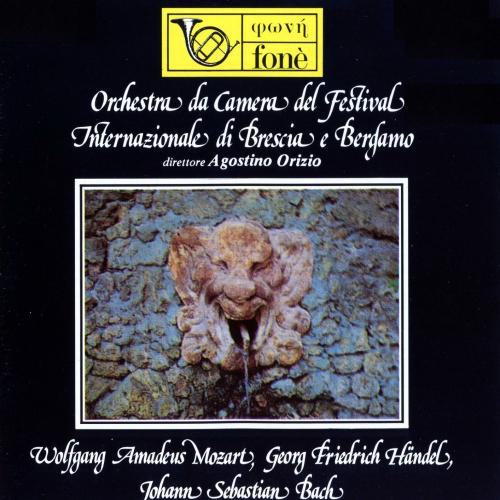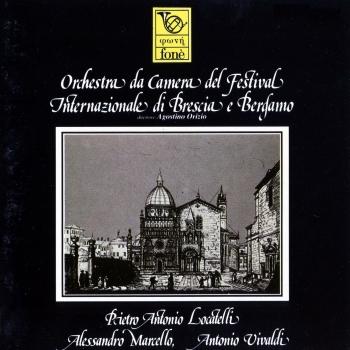
Mozart, Händel, Bach (Remastered) Orchestra da Camera del Festival Internazionale di Brescia e Bergamo & Agostino Orizio
Album Info
Album Veröffentlichung:
1990
HRA-Veröffentlichung:
17.02.2023
Label: fonè Records
Genre: Classical
Subgenre: Chamber Music
Interpret: Orchestra da Camera del Festival Internazionale di Brescia e Bergamo & Agostino Orizio
Komponist: Wolfgang Amadeus Mozart (1756-1791), Georg Friedrich Händel (1685-1759), Johann Sebastian Bach (1685–1750)
Das Album enthält Albumcover Booklet (PDF)
- Wolfang Amadeus Mozart (1756 - 1791): Sinfonia concertante in mi bemolle maggiore per quattro strumenti a fiato e orchestra d’archi KV 297 b:
- 1 Mozart: Sinfonia concertante in mi bemolle maggiore per quattro strumenti a fiato e orchestra d’archi KV 297 b, Allegro 13:56
- 2 Mozart: Sinfonia concertante in mi bemolle maggiore per quattro strumenti a fiato e orchestra d’archi KV 297 b, Adagio 08:36
- 3 Mozart: Sinfonia concertante in mi bemolle maggiore per quattro strumenti a fiato e orchestra d’archi KV 297 b, Andantino 09:09
- Goerge Friedrich Händel (1685 - 1759): Concerto in re minore op. 7 n. 4 per organo e orchestra:
- 4 Händel: Concerto in re minore op. 7 n. 4 per organo e orchestra, Adagio 05:36
- 5 Händel: Concerto in re minore op. 7 n. 4 per organo e orchestra, Allegro a Ad Libitum (Adagio: quasi una fantasia) 06:57
- 6 Händel: Concerto in re minore op. 7 n. 4 per organo e orchestra, Allegro 05:06
- Johann Sebastina Bach (1685 - 1750): Concerto in re minore BWV 1060 per violino, oboe, archi e basso continuo
- 7 J.S. Bach: Concerto in re minore BWV 1060 per violino, oboe, archi e basso continuo, Allegro 05:10
- 8 J.S. Bach: Concerto in re minore BWV 1060 per violino, oboe, archi e basso continuo, Adagio 05:35
- 9 J.S. Bach: Concerto in re minore BWV 1060 per violino, oboe, archi e basso continuo, Allegro 04:01
Info zu Mozart, Händel, Bach (Remastered)
Mozart wrote the splendid Sinfonia Concertante K V 297b in l 778, during a stay in Paris. for a “Concert Spirituel” and it is without doubt the less known and the least damaged by questionable interpretations of the Sinfonie Concertanti. At this time in Paris. (as, indeed in Italy), there was a certain leaning towards the baroque Concerto Grosso with its alternating “Concertino” and “Ripieno”. As a result. the so called “Sinfonia Concertante”, with the interplay between soloists (always two or more in number) and orchestra which recalls baroque practice, enjoyed great popularity. Mozart himself wrote another wonderful “Sinfonia Concertante” for violin and viola, KV 364. The “gallante” spirit of the Mannheim school was still alive in Paris. and it was for four soloists from Mannheim that Mozart wrote the work heard on this recording, K V 297b. It was never actually performed for one of the “Concerts Spirituels” and the reason f or this remains one of the enigmas which surround many of Mozart’s works. The fate of the KV 297b is baffling: deemed to be a composition of fundamental importance by the best and most well respected wind ensembles over the course of time. not only was it not performed at the “Concerts Spirituels”, but the original manuscript actually went missing under mysterious circumstances. ...
If Bach’s “interior” cosmopolitanism and Handel’s realistic, actual aperture on the world place the two greatest craftsmen of the late musical baroque on different levels, the German masters shared, during their lives, great fame as performers. For Bach, whose music was too often misunderstood in his lifetime, this fame was his only point of contact with what is commonly know as success; for Handel, it was one of the many facets of his offering to the European public as a versatile “personality” and fashionable artist. Georg Friedrich Handel must have been an extraordinary organist judging by the eye-witness accounts of Charles Burney and Sir John Hawkins, two famous figures of eighteenth century musical England and both friends of Handel who himself enjoyed renown and success in London. Particularly impressive to the listener was the German musician’s admirable gist for extemporization, both in the “solo” parts of a concerto and in the free improvisations. Even apart from the words of praise of Hawkins and Burney, we are left with the Concertos for organ and orchestra, about twenty in all, as testimony to an art which amazed Handel’s contemporaries. This musical form, concerto for organ and orchestra, was one which, with few exceptions, was born and subsequently died with Handel. The origin of these works, which Handel himself played between acts of his Oratorios, is particular, and we can therefore attribute them to the London period, that in which the German musician received, through these Oratorios. his fame as an operatic composer. ...
It is only recently that Bachian exegesis are arriving at conclusions which, while on one hand are shown to be nearer historical truth, on the other, cannot fail to provoke a certain sense of loss in those who may still be tied (and not always through their own limited point of view) to an impression of the Maestro of Eisenach handed down through the eighteen hundreds in Germany where romanticism was strongly influenced by a very Germanic mysticism and nationalism. This “new image”, as it is currently defined, has been strongly enforced bythe late lamented Friedrich Blume and in recent years found a proud crusade in Piero Buscaroli. The latter has presented us with a more “tender” impression of Bach, sanguine and veracious which if not actually a thousand miles from the now “passé” portrait of the fervid craftsman of sound, wholly devoted to offering his wonderful “wares” “Soli Deo Gloria”, is nonetheless far-removed. Not only, therefore, was Bach a divine creator of sacred musical architecture, but a man complete his desire for a full life ever to the point of being mundane, almost courtly. Where the old image of Bach is perhaps the most sullied is in his post as “Cantor” at Leipsig: new research on the chronology of his work testifies not only that his ardent activity as a composer of sacred cantatas carne to an early end, but also that for many of these sacred works, the Passions included, Bach drew on elements from preceding compositions. ...
Orchestra da camera del festival internazionale di Brescia e Bergamo
Agostino Orizio, conductor
Digitally remastered
Agostino Orizio
was a pupil of Arturo Benedetti Michelangeli and activity throughout Europe. He owes the beginning of his conducting career to meeting Hermann Scherchen. Founder of the International Piano Festival of Brescia and Bergamo and of the Orchestra Gasprao da Salò (currently the Orchestra del Festival Internazionale di Brescia e Bergamo), he has enjoyed enthusiastic success in Itaky, Poland, Romania, the United States, and has recently directed the orchestra on a triumphant tour of the Soviet Union. He has conducted numerous important orchestral groups and his performances have been broadcast many times on radio and television throughout the world. Currently, Maestro Orizio, with the “Orchestra del Festival Internazionale di Brescia e Bergamo” is recording for Foné.
Pietro Borgonovo
began his oboe studies in Milan and subsequently went on to further studies in Freiburg with Heinz Hollinger. His career as a soloist began in 1975, and he has since taken part in major international music festivals. In the past he has taught at the conservatories in Bolzano and Genova and currently holds the chair of advanced oboe studies at the Scuola di Musica di Fiesole. Since 1978, he has been principal oboe in the Symphony Orchestra of the RAI in Turin.
Vincenzo Mariozzi
studied at the Conservatorio di S. Cecilia in Rome with Maestro Gambacurta. He held the position of first clarinet at the Teatro Massimo orchestra in Palermo and is currently principal clarinet of the “Orchestra Stabile dell’Accademia Nazionale di Santa Cecilia”. In 1967 he won a prize at the Geneva International Competition. He has been a soloist under dome of the world’s most important conductors, among them Previtali, Ceccato, Marriner, Maag, Sawallisch and Sinopoli. At the present he holds the chair of clariner at the Conservatorio di Santa Cecilia.
Rino Vernizzi
trained at the Conservatorio Arrigo Boito in Parma under Enzo Muccetti. The winner of five competitions. he has played first bassoon with the most important Italian orchestras. He works intensively in Italy and abroad with some of today’s most important conductors. He has made six records, the most recent of which being Antonio Vivaldi’s Bassoon Concerto with the Orchestra da Camera di Santa Cecilia in Rome.
Marcello Rota
obtained his diploma in 1974 in Alessandria under the guidance of Giacomo Zoppi, and since 1977 he has been first horn in the Orchestra della RAI in Turin. He studied conducting with Igor Markevitch and Franco Ferrara. He has been active both as soloist and as conductor with many groups including “I Solisti del Vivaldi”, “I Solisti della RAI”, “L’Orchestra da Camera di Padova”, and with symphony orchestras including the Philarmonic Orchestra of Hamburg. A teacher at the ECC sponsered school of Alto Perfezionamento in Saluzzo he has recently recorded Mozart’s Duetti Inediti, K 487, playing both the parts.
Ernesto Merlini
gained his diploma in organ, composition for organ, choral music and choral conducting as well as harpsichord at the conservatory of Piacenza. He has taken part in the most important international organ festivals and has to his name a huge number of concerts in Italy and abroad. The harpsichord player with the Orchestra del Festival Internazionale di Brescia e Bergamo, he has also collaborated with the Solisti Veneti under Claudio Scimone and with the Scaligeri. He teaches at the Conservatory of Piacenza.
Marco Rizzi
was born in Milan in 1967 and trained at the Giuseppe Verdi Conservatory under Giuseppe Magnani. He has won many national and international competitions and since 1984, he has been a member of the European Community Youth Orchestra. In spite of his youth, he has already behind him a long concert career as a soloist and as a member of important orchestras including L’Orchestra dell’Angelicum of Milan, the Orchestra Sinfonica della RAI of Mlilan, the Orchestra del Festival Internazionale of Brescia and Bergamo.
The “Orchestra del Festival Internazionale di Brescia e Bergamo
was founded by Agostino Orizio under the name of “Orchestra Gasparo da Salò” and is this year celebrating its twenty-fifth anniversary. In 1964, it became the official chamber orchestra of the “Arturo Benedetti Michelangeli” International Piano Festival. Since then, while still fulfilling its “established” commitment of accompanying the soloist of Piano Festival, the orchestra, directed by Agostino Orizio and made up of instrumentalists of established reputations, has been internationally active, dedicating particular attention to eighteen century works, unpublished pieces, or rare performances. It has been a guest of the world’s most important musical organizations among which Hunter College in New York, Constitution Hall in Washington, the Leningrad Philarmonic, the Conservatories of Moscow, Strasbourg and Prague, the Beethovensaal in Bonn, the Wiener Konzerthaus, the Bratislav Festival, the Salle Gaveau in Paris, the Teatro alla Scala in Milan, the Fenice in Venice, the Accademia Filarmonica in Rome, etc. for more than a thousand concerts. It has played at the Vatican in the presence of Pope Paul VI with the participation of Arturo Benedetti Michelangeli, and Strasbourg for the Council of Europe. It has made many broadcasts for some of the most important radio and television networks in the world.
Booklet für Mozart, Händel, Bach (Remastered)











